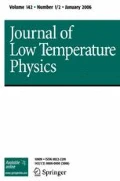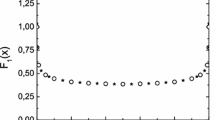Abstract
We examine several features of Bose-Einstein condensation (BEC) in an external harmonic potential well. In the thermodynamic limit, there is a phase transition to a spatial Bose-Einstein condensed state for dimensionD≥2. The thermodynamic limit requires maintaining constant average density by weakening the potential while increasing the particle numberN to infinity, while of course in real experiments the potential is fixed andN stays finite. For such finite ideal harmonic systems we show that a BEC still occurs, although without a true phase transition, below a certain “pseudo-critical” temperature, even forD=1. We study the momentum-space condensate fraction and find that it vanishes as\({1 \mathord{\left/ {\vphantom {1 {\sqrt N }}} \right. \kern-\nulldelimiterspace} {\sqrt N }}\) in any number of dimensions in the thermodynamic limit. InD≤2 the lack of a momentum condensation is in accord with the Hohenberg theorem, but must be reconciled with the existence of a spatial BEC inD=2. For finite systems we derive theN-dependence of the spatial and momentum condensate fractions and the transition temperatures, features that may be experimentally testable. We show that theN-dependence of the 2D ideal-gas transition temperature for a finite system cannot persist in the interacting case because it violates a theorem due to Chester, Penrose, and Onsager.
Similar content being viewed by others
References
M. H. Anderson, J. R. Ensher, M. R. Matthews, C. E. Wieman, and E. A. Cornell,Science 269, 198 (1995).
K. B. Davis, M.-O. Mewes, M. R. Andrews, N. J. van Druten, D. S. Durfee, D. M. Kurn, and W. Ketterle,Phys. Rev. 75, 3969 (1995).
C. C. Bradley, C. A. Sachett, J. J. Tollett, and R. G. Hulet,Phys. Rev. 75, 1687 (1995).
M. F. M. Osborne,Phys. Rev. 76, 396 (1949).
J. M. Ziman,Phil. Mag. 44, 548 (1953).
D. L. Mills,Phys. Rev. 134, A306 (1964).
D. F. Goble and L. E. H. Trainor,Can. J. Phys. 44, 27 (1966);Phys. Rev. 157, 167 (1967).
D. A. Kruger,Phys. Rev. 172, 211 (1968).
Y. Imry,Ann. Phys. 51, 1 (1969).
M. N. Barber, inPhase Transitions and Critical Phenomena, ed. C. Domb and M. S. Green (Academic Press, London, 1983), Vol. 8, p. 146.
S. Grossmann and M. Holthaus,Z. Naturforsch. 50a, 323 (1995);Z. Phys. B 97, 319 (1995).
W. J. Mullin, “Pseudo-Bose Condensation in Finite Ideal Systems” unpublished report, 1981.
W. Ketterle and N. J. van Druten,Phys. Rev. A 54, 656 (1996).
P. C. Hohenberg,Phys. Rev. 158, 383 (1967).
C. V. Chester, inLectures in Theoretical Physics, ed. K. T. Mahanthappa (Gordon and Breach, Science Publishers, Inc., New York, 1968), Vol. 11B, p. 253
C. V. Chester, M. E. Fisher, and N. D. Mermin,Phys. Rev. 185, 760 (1969).
O. Penrose and L. Onsager,Phys. Rev. 104, 576 (1956).
J. J. Rehr and N. D. Mermin,Phys. Rev. B 185, 3160 (1970).
R. Masut and W. J. Mullin,Am. J. Phys. 47, 493 (1979).
S. deGroot, G. J. Hooyman, and C. A. ten Seldam,Proc. R. Soc. (London) A 203, 266 (1950).
C. E. Campbell, J. G. Dash, and M. Schick,Phys. Rev. 26, 966 (1971).
V. Bagnato, D. Pritchard, and D. Kleppner,Phys. Rev. A 35, 4354 (1987).
V. Bagnato and D. Kleppner,Phys. Rev. A 44, 7439 (1991).
S. Grossmann and M. Holthaus,Phys. Lett. A 208, 188 (1995);Z. Naturforsch. 50a, 921 (1995).
W. Krauth,Phys. Rev. Letters 77, 3695 (1996).
M.-O. Mewes, M. R. Andrews, N. J. van Druten, D. M. Kurn, D. S. Durfee, and W. Ketterle, preprint.
H. Haugerud and F. Ravndal, cond-mat/9509041.
H. Haugerud, T. Haugset, and F. Ravndal, cond-mat/9605100; cond-mat/9611061
K. Kirsten and D. J. Toms,Phys. Lett. B 368, 119 (1996); cond-mat/9604031; condmat/9607047; cond-mat/9608032.
A. Widom,Phys. Rev. 168, 150 (1968).
F. London,Superfluids (Dover, New York, 1964), Vol. II, p. 203; J. E. Robinson,Phys. Rev. 83, 678 (1951).
M. Abramowitz and I. A. StegunHandbook of Mathematical Functions (Dover, New York, 1972).
Author information
Authors and Affiliations
Rights and permissions
About this article
Cite this article
Mullin, W.J. Bose-Einstein condensation in a harmonic potential. J Low Temp Phys 106, 615–641 (1997). https://doi.org/10.1007/BF02395928
Received:
Revised:
Issue Date:
DOI: https://doi.org/10.1007/BF02395928



